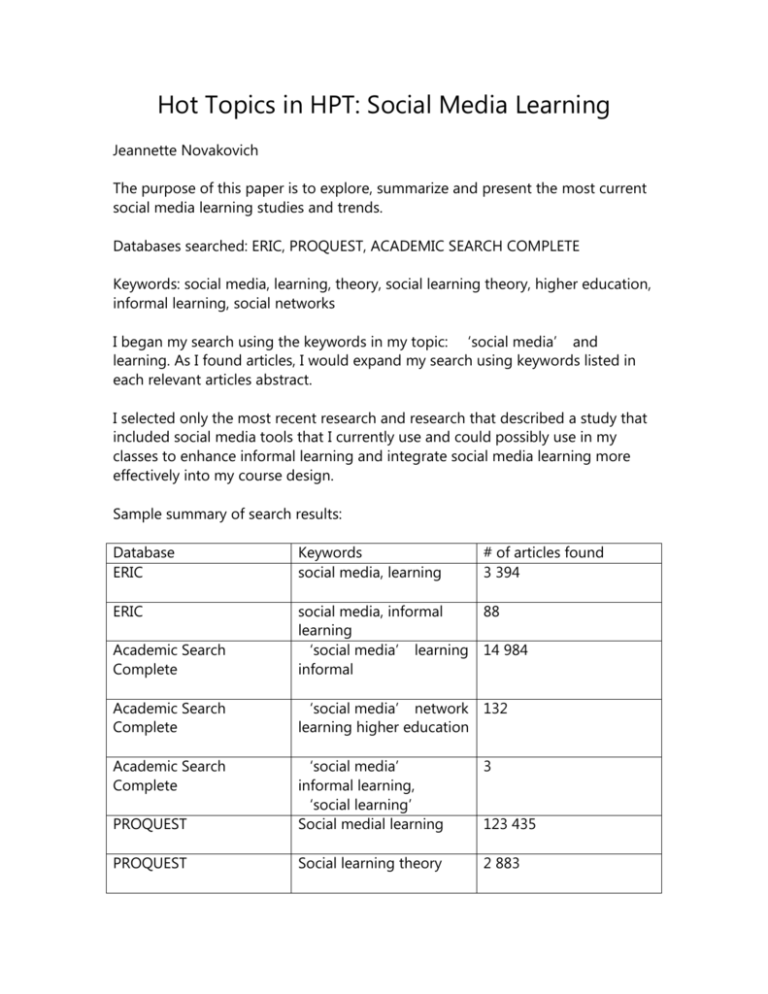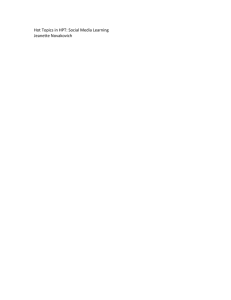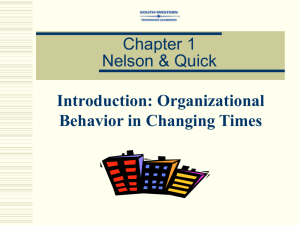Hot Topics in HPT
advertisement

Hot Topics in HPT: Social Media Learning Jeannette Novakovich The purpose of this paper is to explore, summarize and present the most current social media learning studies and trends. Databases searched: ERIC, PROQUEST, ACADEMIC SEARCH COMPLETE Keywords: social media, learning, theory, social learning theory, higher education, informal learning, social networks I began my search using the keywords in my topic: ‘social media’ and learning. As I found articles, I would expand my search using keywords listed in each relevant articles abstract. I selected only the most recent research and research that described a study that included social media tools that I currently use and could possibly use in my classes to enhance informal learning and integrate social media learning more effectively into my course design. Sample summary of search results: Database ERIC Keywords social media, learning # of articles found 3 394 ERIC Academic Search Complete social media, informal 88 learning ‘social media’ learning 14 984 informal Academic Search Complete ‘social media’ network 132 learning higher education Academic Search Complete 3 PROQUEST ‘social media’ informal learning, ‘social learning’ Social medial learning PROQUEST Social learning theory 2 883 123 435 Bibliography of Selected Sources Allen, M., Naughton, J., & Ellis, R. (2011). Social Learning. T+D, 65(8), 50-55. Dabbagh, Nada & Kitsantas, Anastasia (2011) Personal Learning Environments, social media, and self-regulated learning: A natural formula for connecting formal and informal learning, The Internet and Higher Education, 15 (2) 38. 1 Doi: 10.1016/j.iheduc.2011.06.002. Heibergert & E. Loken (2011). The effect of Twitter on college student engagement and grades. Journal of Computer Assisted Learning 27, 199132. doi:10.1111/j.1365-2729.2010.00387.x Hung, Hsiu-Ting & Yuen, Steve Chi-Yin (2010). Educational use of social networking technology in higher education. Teaching in Higher Education 15 (6) 703-714. Lampe, C., Wohn, D. Y., Vitak, J., Ellison, N. B., & Wash, R. (2011). Student use of facebook for organizing collaborative classroom activities. International Journal of Computer-Supported Collaborative Learning, 6(3), 329-347. doi:10.1007/s11412-011-9115-y Manion, Christopher E.; Selfe, Richard “Dickie” (2012). Sharing an Assessment Ecology: Digital Media, Wikis, and the Social Work of Knowledge. Technical Communication Quarterly. , 21 (1) 25-45. DOI: 10.1080/10572252.2012.626756 Rinaldo, Shannon B. Tapp, Suanne, and Laverie, Debra A. (2011). Learning by tweeting: using twitter as a pedagogical tool. Journal of Marketing Eudation. 33 (2) 193-203, doi: 10.11.77/273475311410852. Tay, E., & Allen, M. (2011). Designing social media into university learning: technology of collaboration or collaboration for technology?. Educational Media International, 48(3), 151-163. doi:10.1080/09523987.2011.607319 Wodzicki, Katrin, Schwammlein, Eva, Moskaliuk, Johannes (2012). “Actually, I wanted to learn”: study-related knowledge exchange on social networking sites. Internet and Higher Education 14 9-14. doi:10.1016/j.iheduc.2011.05.008 Allen, M., Naughton, J., & Ellis, R. (2011). Social Learning. T+D, 65(8), 50-55. The purpose of this article was to present the updated ASTD competency model that integrates social learning and it effects on professional development and training in the workplace. The authors answered three questions: What is social learning? How can you use social media in the work place in terms of tools and technology? What do learning professionals need to know to be successful integrating technology? The literature review covered the key points in current ASTD literature, and reviewed recent ASTD business surveys: 80% respondents believed that social media should be used more frequently 83% respondents felt informal learning enhances employee and organizational learning Methodology The ASTD commissioned the ASTD Competency Model update study, a mixed methods study that combined focus groups with leaders in the field and surveys of ASTD members. Results and Discussion Social learning occurs informally when professional development or training occurs on social media networks. Social media can be used for collaboration in terms of exchanging information and as a communication channel. Learning professionals need to develop a high level of fluency in terms of the use of social media tools. Resistance to social media occurs because it contains the term “social”, which translates to managers as being wasted time and resources. Other concerns are security and privacy issues and organizational culture. Social learning is now a key component of ASTD Competency Model and shares a spot with managing organizational knowledge. Suggested future research would involve testing treatments or instructional designs that facilitate informal learning through social media to discover industry best practices. Dabbagh, Nada & Kitsantas, Anastasia (2011) Personal Learning Environments, social media, and self-regulated learning: A natural formula for connecting formal and informal learning, The Internet and Higher Education, 15 (2) 3-8. 1 Doi: 10.1016/j.iheduc.2011.06.002. Research Problem: The purpose of the study was to explore the development of personal learning environments or PLE’s as a means of integrating informal and formal learning with the use of social media to foster self-efficacy. The researchers asked the following questions: What does the literature say on this topic? What are the connections among PLE’s, social media and self-regulated learning? What social media instructional design framework would best promote learning? First, the literature review examines the use of social media in higher education and found that it has a number of purposes: Communication Collaboration Creative expression The next goal was to define the use of PLE’s, social media networks used to organize, create and share content on externally hosted web networks and tied the development of these shared yet personal spaces to self-regulated learning. Within these spaces a combination of formal and informal learning takes place. The literature review was comprised of a broad body of literature that traced the use of social media in higher education and identified the purpose and type of learning that took place. The article did not include a research study. It was critical in nature and developed a theory and paradigm for integrating social media into course design. The paradigm was comprised of three stages: Personal information management Social interaction and collaboration Information aggregation and management Social media can be utilized to teach students how to self-regulate learning, formally and informally through the structure of the course design. The paradigm needs to be tested to evaluate its usefulness and claims that it will foster learning. I recommended that the paradigm is tested through a formal study.






